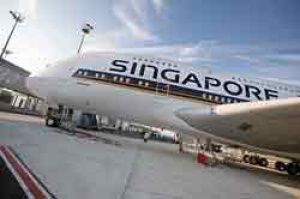Singapore Airlines first quarter 2009 results

Group revenue fell 30% from April – June 2008, down by $1,260 million, as carriage and both passenger and cargo yields declined, the former reflecting increased competition and promotional fare activities.
Group expenditure at $3,191 million was $598 million (-15.8%) lower than the same quarter in the preceding financial year. The drop in the price of jet fuel provided relief of $1,140 million, partially offset by fuel hedging losses of $287 million (compared to hedging gains of $349 million last year).
The Group recorded an operating loss of $319 million for the first quarter, against an operating profit of $343 million last year.
The operating results of the main companies in the Group are as follows:
ADVERTISEMENT
o Singapore Airlines Loss of $ 271 million (profit of $265 million previously)
o SATS Group Profit of $ 44 million (+14.4%)
o SIA Engineering Profit of $ 12 million (-25.0%)
o SilkAir Loss of $ 3 million (profit of $10 million previously)
o SIA Cargo Loss of $ 104 million (profit of $5 million previously)
Steps to reduce cost
Several steps have been taken by the Company to contain costs, including a freeze on hiring, unpaid leave, wage cuts and deferment of non-essential projects.
Consequent to the first quarter results, the monthly variable component of employees’ salaries will be cut in accordance with the Collective Agreements signed with the respective unions.
Together, these measures to trim staff costs will provide estimated savings of $60 million for the current financial year.
In addition, the Company is continuing its efforts to eliminate wastage and duplication and to negotiate with vendors to reduce rates.
FLEET AND ROUTE DEVELOPMENT
During the quarter, Singapore Airlines took delivery of two Airbus A380-800s and four Airbus A330-300s, and decommissioned three Boeing B747-400s. As at 30 June 2009, the operating fleet comprised 107 passenger aircraft – nine B747-400s, 77 B777s, eight A380-800s, eight A330-300s and five A340-500s – with an average age of 5 years and 11 months.
The Company adjusted capacity to match demand. Services to Vancouver via Seoul were suspended from April 2009, while three-times-weekly flights to Moscow via Dubai were withdrawn from July 2009. From August 2009, services to Tokyo via Bangkok will be discontinued. Frequencies to Manchester, Rome, Zurich, Beijing, Guangzhou, Fukuoka, Colombo, Dhaka, Male, Mumbai and New Delhi were reduced during the quarter. Conversely, a fourth daily frequency was recently added to Manila and the larger A380-800 is now being deployed to Hong Kong.
OUTLOOK
The price of jet fuel is at less than half what it peaked at last year, but remains volatile. However, losses from hedges, which were contracted when fuel prices were at historical highs, are expected but will taper off over the course of the financial year as these hedges are settled.
Air cargo carriage has stabilized in the last few months, and industry indicators have shown some improvement. Still, the outlook for air cargo remains challenging, with yields expected to remain under pressure from excess capacity in the market.
The Group’s first quarter performance reflected the adverse business conditions for airlines. If these conditions continue, the Group expects to make a loss for the full year. Revenues from the airline operations exceeded cash expenditure, although not enough to cover depreciation charges. Net operating cash flow is expected to remain positive for the rest of the financial year. The Group’s cash balance remains strong and the Company does not foresee any necessity to raise capital.

